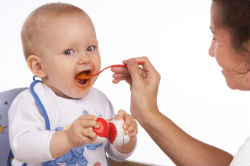Tips for Feeding Your One-Year-Old
By baby’s first birthday, about half of what you will be feeding your one-year-old will be solids. Continue to feed most solid foods to your baby by spoon, since you are likely to get more food into baby’s mouth than on the floor. Yet, if your baby is the “do it myself” type, finger foods may be the main fare by this time.
Here are some tips gleaned from the Sears family-feeding experiences, as well as tips shared by patients in our pediatric practice on feeding your one-year-old.
Keep Feeding Times Short
Remember, tiny babies still have tiny tummies. Small, frequent feedings are still the best. Also, try feeding your one-year-old small helpings. Most babies seldom take more than 1 or 2 tablespoons of food at any one meal. Don’t overwhelm baby with a whole pile of food on her plate. Begin with a small dollop and add more as baby wants more.
Give Your Baby a Bone
Our babies have enjoyed a chicken leg bone with all the tiny bone slivers removed and a small amount of cooked meat remaining. Beginning around nine months, babies love to hold this bone like a rattle, gnaw on it, bang it, transfer it from hand to hand, teethe on it and play with it. They even, occasionally, eat a little chicken.
Pressure Tactics make Feeding Your One-Year-Old Harder, not Easier
Don’t force food when feeding your one-year-old, as this could create long-term unhealthy attitudes about eating. The parent’s role is to select nutritious foods, prepare them well and serve them creatively, matched to baby’s individual capabilities and preferences. Baby’s role is to eat the amount he wants at the time, according to his needs, moods, capabilities and preferences. We have taught all of our children to swim, and we think of feeding similar to teaching swimming — being neither over- protective nor over-restrictive. Allow a child to explore and experiment. Allow a certain amount of mess, but don’t let it get out of control. Above all, teach your child that food is to be enjoyed.
Expect Erratic Feeding Habits
There may be days when your baby eats solids six times, or she may refuse solids three days in a row and only want to breastfeed or take a bottle.
Understand that Food Fears are Normal
When feeding your one-year-old, help baby overcome food fears by taking a bite of an unfamiliar food first and let your baby catch the spirit of your enjoyment. Expect baby to explore a new food before she eats it — just like adults want to know what they’re eating. One way to encourage the cautious feeder is to take a bite of the new food yourself. Then place some food on his index finger and guide his own finger-full of food into his mouth.
Gradually Increase Variety and Texture
Fruits and vegetables should be strained when feeding your one-year-old. (If you wait until six months to start solids, you’ll probably skip this stage.) As babies gain eating experience, they can advance to pureed foods, then foods that are finely minced. Most babies can begin to accept chopped foods by one year of age.
Settle the Squirmer
Here is a toy trick that worked for one of our babies who would constantly windmill her arms during feeding. Use three plastic spoons – one spoon for each of her hands to occupy them and one for you to feed her. Also, try this toy trick: put toys with suction cups on a highchair tray so she can play with them with her hands while you sneak food into her mouth. Sometimes when babies open their mouths to suck on toys, this primes them to open their mouths to receive food.
Use Camouflage when Feeding Your-One-Year-Old
Cover more nutritious, but less favorite, foods with one of baby’s favorites. We often place a thin layer of applesauce over the vegetables or meat. Get the applesauce (or other favorite) on baby’s tongue first and then put a scoop of the more nutritious, but less liked, food on top of it.
Let Baby Eat Off Your Plate
Sometimes babies just don’t want to eat like a baby, neither baby food nor off baby plates. Around one year of age, babies enjoy sitting on parents’ laps and picking food off their plate, especially mashed potatoes and cooked, soft vegetables. You can also put baby’s food on your plate and trick the little gourmet into eating his own food.
Let Baby Enjoy the Lap of Luxury
If your child refuses to get in or stay in his high-chair, let him sit on your lap and eat off your plate. If baby begins messing with your food, place a few morsels of food on the table between baby and plate to direct his attention away from your dinner.
Overcome Lip Lock
To relax tight lips from refusing a feeding, back off and over-enjoy the food yourself. Model the excitement by replaying the old reliable, “Mmmmmm goooood!” As your baby watches you open your mouth and savor the food, he may catch the spirit and relax his mouth and his attitude. Try feeding your one-year-old some of his favorite foods as a teaser. As he opens his mouth for his favorite food, quickly follow with the food you wanted him to try.
Minimize the Mess when Feeding Your One-Year-Old
Too much food on a baby’s dish leads to two-fisted eating and major mess-making. Encourage neatness by scattering only a few morsels of finger foods on baby’s tray at a time and refill as necessary.
When feeding your one-year-old, each new developing skill has its nutritional benefits and humorous nuisances. Baby’s newly developing thumb and forefinger pincer grasp and finger pointing stimulates him to want to pick up tiny morsels of food and feed himself, yet it also creates an opportunity for more messes. Allow baby the luxury of messing around a bit with his newly-discovered utensils. Believe it or not, baby is actually learning from this mess, sort of like the conclusion that the author Ernest Hemmingway came to, “Oh, the joy of just messing around.” While some food makes its way into the mouth, other pieces scatter. Food- flinging , dropping and smearing is a usual mealtime antic parents can expect to deal with. To discourage flinging and give the food a fighting chance to make it into baby’s mouth, put a few pieces of O-cereals, cooked carrots, pieces of rice cakes and any other bite-size pieces of fruits and vegetables that baby likes on his plate. Then, refill as needed. Feeding your one-year-old by placing a whole pile of food in front of baby is inviting a mess. We have noticed that our babies are fascinated with a pile of cooked spaghetti placed within easy reach. The ability to pick up with the thumb and forefinger enables baby to pick up one strand at a time. Spaghetti-picking holds baby’s mealtime attention longer than most foods. Expect food and utensils to become interesting objects to pick up, bang, drop and fling, which is part of baby’s natural desire to explore and find new uses for his hands. (See Feeding at a Glance: Birth to 24 Months or Feeding Infants & Toddlers for more.)




